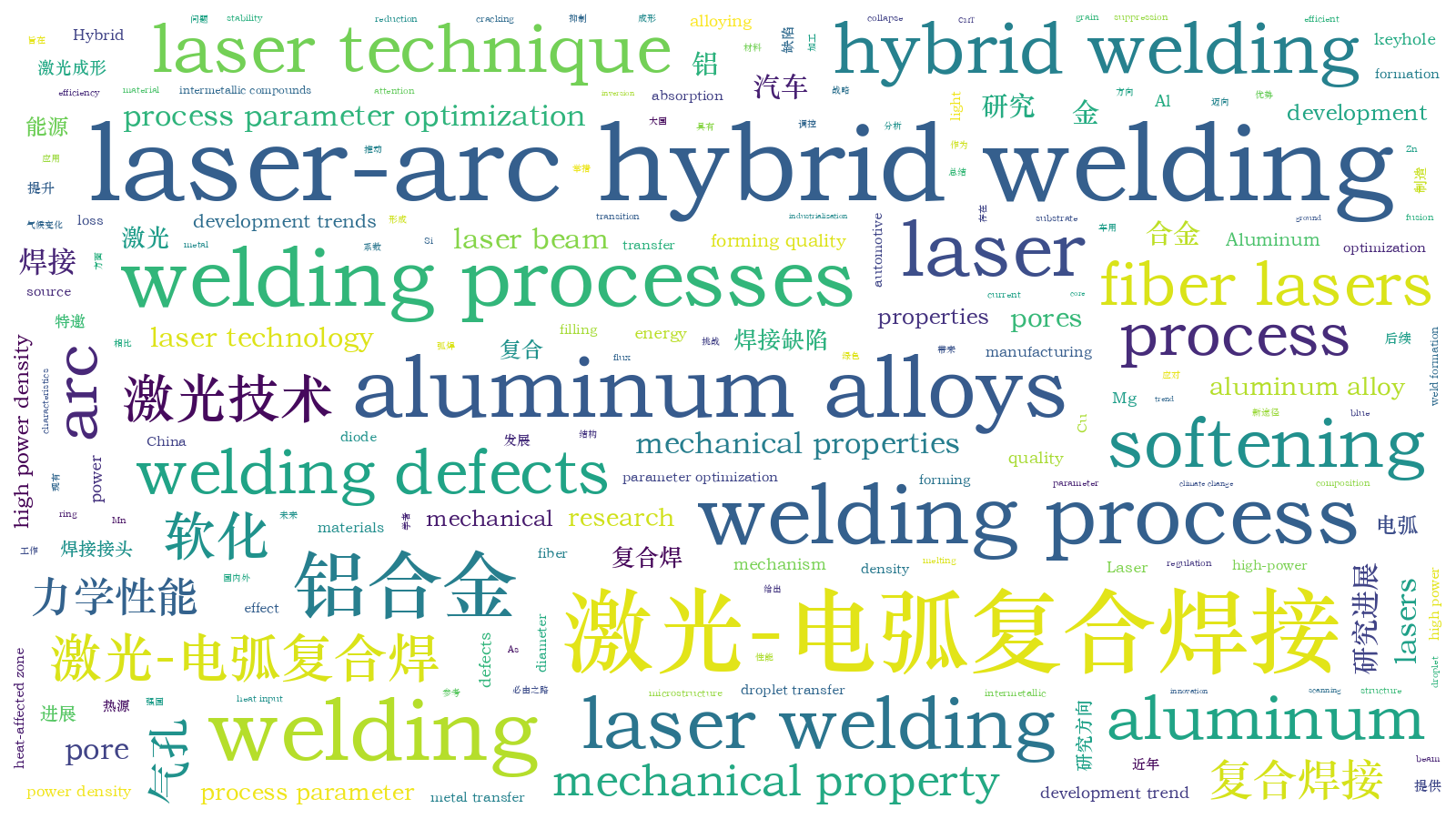新能源汽车用铝合金激光-电弧复合焊接研究进展(特邀)  下载: 533次特邀综述亮点文章
下载: 533次特邀综述亮点文章
The development of new energy vehicles is the effective way for China to transition from a large automobile country to an automobile power; this is also a strategic initiative to address climate change and promote green development. As important materials for manufacturing new energy vehicles, the excellent mechanical properties of automotive aluminum alloys have brought new challenges during the subsequent welding processes. The original fine grains and nanoprecipitates of the automotive aluminum alloy are destroyed by the welding heat source, producing noticeable softening in the weld seam and heat-affected zone. Consequently, the mechanical properties of traditional arc-welded joints are inferior to the requirements of industrialization. High-quality and efficient welding of automobile aluminum alloys is a development trend, and traditional welding processes struggle to satisfy this demand.
The high-power-density fusion welding process, that is, the laser welding process with low heat input, is used to shorten the softening zone and reduce the adverse effects of the heat source on the substrate plates. Moreover, it also significantly improves welding efficiency because of its high power density. However, as a high inversion material, the laser absorption of aluminum alloys is less than 5%, leading to enormous energy wastage and danger. Meanwhile, the fine spot (diameter of 0.2‒0.6 mm) indicates the poor bridging ability of the laser welding process, and the burning loss produces a weld seam with a poor forming quality and high softening degree. Thus, a laser-arc hybrid welding process is used to weld the aluminum alloy. In the laser-arc hybrid welding process, the laser beam and arc interact in a common weld pool, and their synergic effect increases laser absorption and bridging ability. Moreover, wire filling compensates for the burning loss, thereby improving the forming quality and mechanical properties of the weld seam. At the beginning of the 21st century, a laser-arc hybrid welding process was applied to car structure manufacturing. Since then, researchers from China, Italy, and Canada have focused on regulating the microstructure and mechanical properties of laser-arc hybrid welded joints. Owing to the substantial reduction in the price of laser machines, laser-arc hybrid welding of aluminum alloys has received more attention in the past three years.
Automobile aluminum alloys are divided into two categories: heat-treatable aluminum alloys [Al-Mg-Si(Cu) and Al-Zn-Mg(-Cu)] and non-heat-treatable aluminum alloys [Al-Mg(-Mn)]. Considering their characteristics, typical welding defects such as softening, pores, and hot cracking are summarized in Fig. 4, and the softening mechanisms of the heat-affected zone and weld seam are analyzed and summarized in Figs. 5 and 6. The regulatory mechanisms of welded joints using the laser-cold metal transfer (CMT) hybrid welding process and welding seam alloying (solute elements, refined grain elements, and nanometallic intermetallic compounds with high melting points) are summarized in Figs. 8 and 9. The formation mechanism of typical pores in laser-arc hybrid weld is summarized in Fig. 12. To suppress keyhole-induced pores, a scanning laser-arc hybrid welding process is used to improve keyhole stability. The suppression mechanism is illustrated in Fig. 14. Other methods for suppressing keyhole collapse including process parameter optimization, droplet transfer behavior regulation, and external field assistance are also analyzed in this study. Finally, this study summarizes the current problems in the laser-arc hybrid welding process of aluminum alloys and proposes future development trends.
The laser-arc hybrid welding process has many advantages in suppressing welding defects and improving the welding coefficient of automobile aluminum alloys. Based on the softening mechanism, the softening degree of the welded joints is effectively decreased by innovation in the welding process and optimization of the alloying elements. However, commercial welding wires cannot be used for fabricating weld seams with excellent mechanical properties. Enhancing weld seams by welding seam alloying requires extensive research and exploration. Meanwhile, flux-cored welding wires that can be flexibly composition-designed and short-produced are more suitable for the development of new ground filling materials. Recently, new hybrid laser sources such as hybrid diode-fiber lasers, hybrid blue-light diode-fiber lasers, and core-diameter ring light spots have been used to improve the weld formation of automobile aluminum alloys. Thus, the effect of new laser technology on welding defects, particularly pores in laser-arc weld seams, still requires extensive research and exploration.
王晓南, 陈夏明, 环鹏程, 李响, 董其鹏, 骆顺存, 长海博文. 新能源汽车用铝合金激光-电弧复合焊接研究进展(特邀)[J]. 中国激光, 2024, 51(4): 0402102. Xiaonan Wang, Xiaming Chen, Pengcheng Huan, Xiang Li, Qipeng Dong, Shuncun Luo, Nagaumi Hiromi. Review of Laser-Arc Hybrid Welding Process of Aluminum Alloys for New Energy Vehicles(Invited)[J]. Chinese Journal of Lasers, 2024, 51(4): 0402102.







